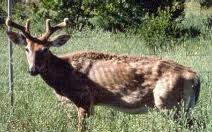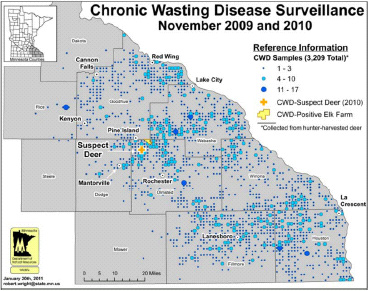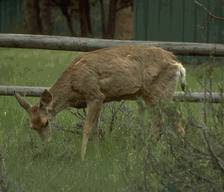Chronic Wasting Disease in Minnesota Deer
January 21st, 2011
In the STrib:
Chronic wasting disease seen in SE Minn. deer
By DENNIS ANDERSON, Star Tribune
A deer killed by an archer in southeast Minnesota last fall is believed to have been infected by chronic wasting disease, the first wild whitetail in the state to be stricken.
Preliminary tests show that a doe felled Nov. 28 near Pine Island in Olmsted County carried the disease. Very little of the animal has been eaten by the hunter or his family, the Department of Natural Resources reported Friday morning, and authorities will pick up the butchered meat for further testing.
CWD is not believed to pose a danger to humans, though hunters and others who eat venison and elk meat are warned that an animal’s brains and spinal cord should be avoided.
The deer was killed about three miles from a captive elk farm near Pine Island that had been shut down recently after CWD was identified in its herd, which subsequently was “de-populated,’’ or killed in its entirety.
DNR big game coordinator Lou Cornicelli said Friday there is no way to determine how the wild deer became infected.
Before it was shot, the animal appeared thin, the archer recalled, but otherwise behaved normally. CWD can gestate in an infected animal for as long as four years before clinical signs of the disease are detected and the animal dies.
The archer has asked state authorities to remain anonymous.
First discovered in Minnesota in a captive elk herd near Aitkin in 2002, and since found in three other captive elk herds, the disease had not previously been found here in wild animals despite continual testing by the DNR.The National Veterinary Services Laboratory in Ames, Iowa, is expected to confirm the initial diagnosis of the Minnesota deer next week.
“It’s possible but not likely,’’ the lab will find the deer wasn’t infected, Cornicelli said.
CWD has long been found in some wild deer in the southern half of Wisconsin, but Cornicelli said the approximate distance between the infected Minnesota animal and the nearest Wisconsin deer found to have CWD was about 150 miles.
DNR and state public health officials were in the Pine Island area Friday morning contacting landowners. Next week the DNR will begin aerial surveys over a region within about a 10-mile radius of where the animal was killed to estimate the number of deer there.
Fixed-winged aircraft will be used initially to find concentrations of deer. Then helicopters will be employed to finalize the population survey.
Researchers and deer managers will establish the area as a CWD-infected zone and finalize a plan that will include killing and sampling a portion of deer there to see if the disease has spread.
Recreational deer feeding within the infected zone will be banned by DNR rule, Cornicelli said.
It’s possible the public will be asked to help kill deer in the area, Cornicelli said. Or DNR sharpshooters will be employed.
Given the difficulty of culling a large enough sample of deer to test, Cornicelli said, it’s likely “as many deer as possible’’ will be killed for testing.
Landowners in the area will have the final determination whether to allow hunting or sharpshooting on their property, said Ed Boggess, acting DNR fish and wildlife division director.
“This is very unfortunate,” said Tom Landwehr, DNR commissioner. “Minnesotans have done much to prevent CWD from entering our wild deer population. The good news is that we are well prepared for an attempt to control the disease and to possibly eliminate it.”
Though all elk have been removed from the Pine Island farm, and the area remains encircled by a high fence, some white-tailed deer have been found within its confines.
But all of those deer are believed to have been killed, said Dr. Paul Anderson of the Minnesota state board of animal health.
“The fence is in good condition,’’ Anderson said. “If deer got in there it’s probably because a gate had been left open. To our knowledge, they’ve all been killed.’’
Cattle are kept inside the fences now, but cattle are not known to be susceptible to CWD.
In Wisconsin, CWD appears to be endemic in some regions among its wild deer, and wildlife officials there have not been able to eliminate it, possibly because it was discovered after too many animals had been infected.
But in New York, after one animal was found with CWD, further testing has discovered no other infected deer, Cornicelli said.
“If I had to put my money on it, our situation would be closer to New York’s than Wisconsin’s,’’ Cornicelli said. “It wasn’t like we just found it. We’ve been doing extensive testing for years, and this is the only deer we’ve determined to be infected.’’



Leave a Reply